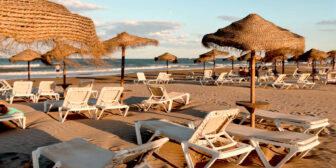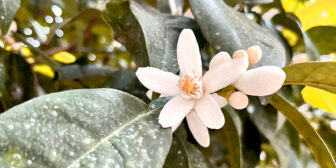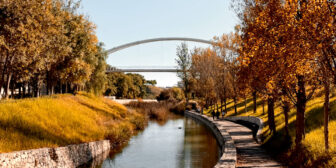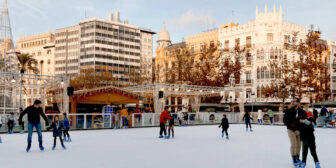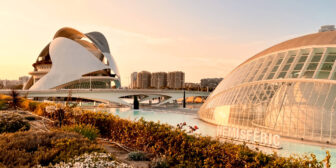If you’re thinking of visiting Valencia in winter, then you’re probably wondering what the winters in Valencia are like, what temperatures you should expect, and what kind of activities are available.
Valencia is one of the southernmost cities in Europe and has some of the mildest winters on the continent. This doesn’t mean you can go swimming in the sea, but oftentimes, you can have lunch on a sunny terrace while wearing a T-shirt.
As one of the sunniest cities in Europe, Valencia is a fantastic choice for a winter getaway if you want to soak up some sun during the colder months.

I’ve spent countless winters in Valencia, and there are still times when I have to pinch myself to make sure I’m not dreaming.
Valencia’s weather in winter is really nice most of the time and because Valencia is the third-largest city in Spain, there a heaps of activities, both indoor and outdoor, that you can enjoy all winter long.
As such, winter can be a wonderful time to visit Valencia and in this guide I want to show you how to make the most of your time.
So below I’m sharing everything you need to know about spending the winter months (December, January and February) in Valencia – from weather and packing tips to the best things to do and the most tasty winter foods you should try.
I hope you find this guide helpful. If this is your first trip to Valencia, make sure you also read my list of the best things to do in Valencia for first time visitors.
In This Article
Why visit Valencia in winter
Valencia is often featured on lists of the best European cities to visit and due to its coastal location and beautiful beaches, many people see it as the perfect summer destination. But Valencia is a great destination year-round. Here are three compelling reasons for visiting in winter.
1. Nice weather
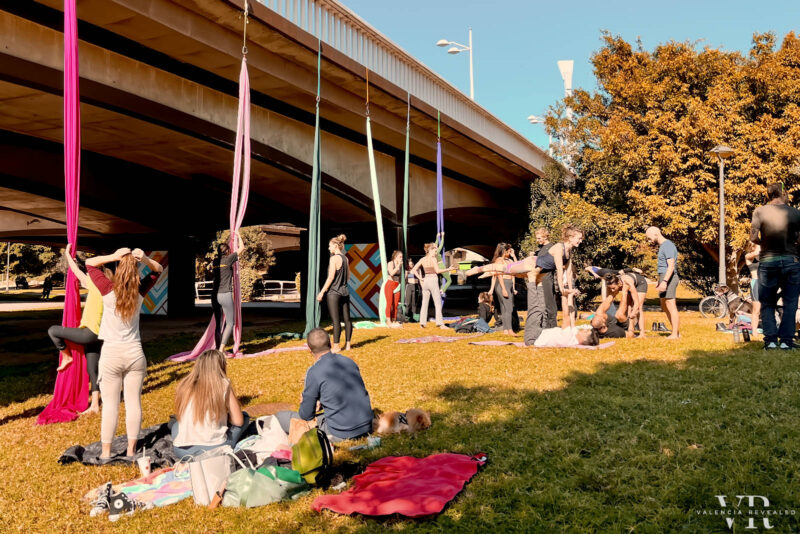
Winters in Valencia tend to be mild and pleasant.
This doesn’t mean all day long T-shirt weather, but unlike most other European destinations, you can forget about wool hats, chunky sweaters and padded boots. In fact, you’ll likely find yourself shedding several layers of clothing.
Winter temperatures in Valencia are typically in the two digits Celsius (above 50ºF) during the day. Nights are colder, but you won’t see big fluctuations on the thermometer.
While winter months are some of the rainiest months in Valencia, they are still relatively dry.
2. Lower prices
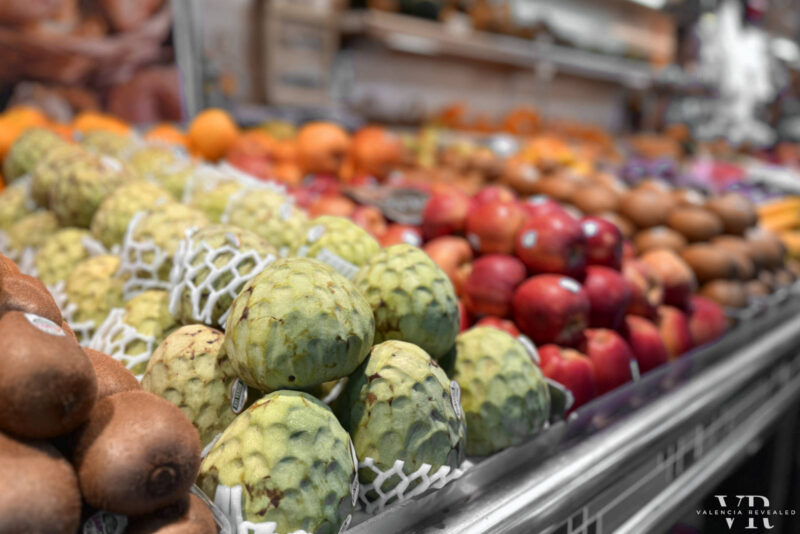
Except for Christmas, winter in Valencia is considered off-season.
From flights to accommodation, everything tends to be cheaper. This means you might be able to stay in a nicer hotel or a central area without breaking the bank.
I highly recommend staying in the Old Town when visiting Valencia in winter for a variety of reasons I’ll talk about below.
Winter is also the peak season for several fruits, such as persimmons, custard apples, grapes and oranges, so they are not only at their tastiest but also at their cheapest.
3. Fewer tourists and a more local atmosphere
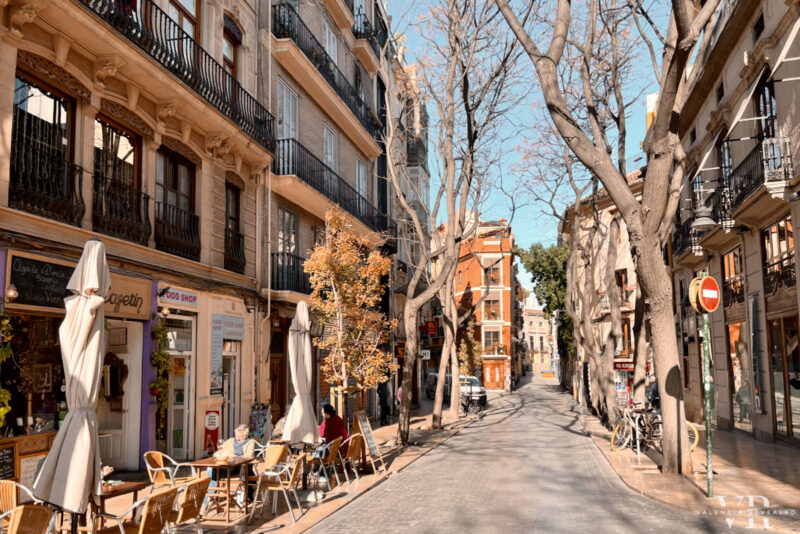
As mentioned before, many people see Valencia as a summer destination. So hotels and tourist attractions are less busy during winter.
But the city doesn’t come to a halt. From Black Friday to January 5th, many locals are out and about looking for presents while restaurants are busy hosting company Christmas dinners.
During this time of the year, it is customary for friends and families to meet for coffee or have dinner together, so it’s best to make a reservation in advance whenever possible.
January and February are more quiet but still full of excitement as this is when the carnival and several other festivals take place.
Weather in Valencia in winter
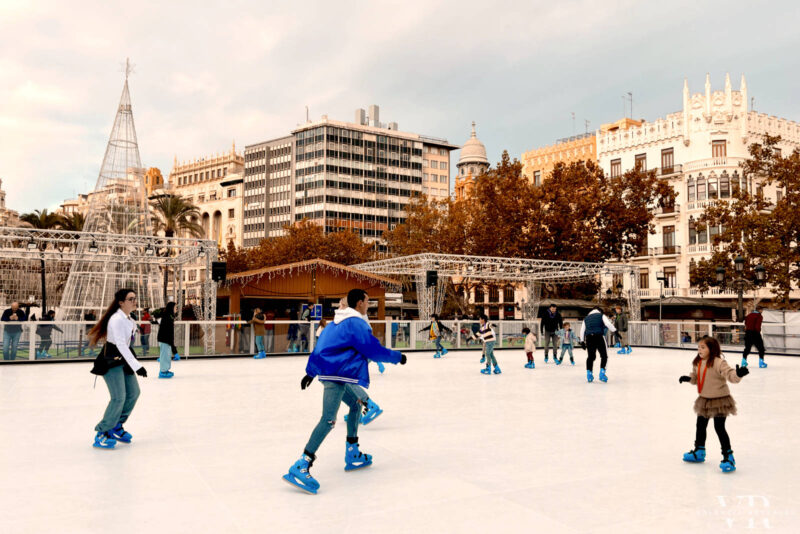
Winter in Valencia lasts from the end of November until the end of February. During this time, you can expect the shortest days of the year (between 9h 30min and 11h of daylight) and the lowest temperatures.
This doesn’t mean freezing weather though, as Valencia has a Mediterranean climate with mild winters.
Temperatures in Valencia in winter
Daytime temperatures typically range from 10ºC to 20ºC (50ºF to 68ºF). At times, maximums can even reach 25ºC (77ºF), but you’ll definitely notice a significant contrast between being in the shade and in the sun.
At night, winter temperatures in Valencia are in the low teens or even in the single digits Celsius (somewhere between 53ºF and 35ºF).
As a general rule of thumb, temperatures never drop below 0ºC (32ºC). But due to the proximity to the sea, winters in Valencia can be windy and humid.
As a consequence, the real feel can be a few degrees Celsius lower from what the thermometers suggest, which can result in a certain degree of discomfort.
Luckily this is not a daily occurrence and for the most part, you can enjoy sunny days with beautiful blue skies.
Precipitations in Valencia in winter
Winters in Valencia are relatively dry and you can easily enjoy the city for weeks without getting out your umbrella. But torrential rains are also common in winter and wet spells can last for days on end.
Basically, you could visit Valencia for two or three weeks and not see a drop of rain the whole time, or be in Valencia for a few days and encounter nothing but rain and overcast skies.
In Valencia, rainy and sunny days never come alone, especially in winter.
Valencia weather compared to other Spanish cities
Valencia is warmer than Barcelona during winter. While both cities are located by the sea, Valencia is situated further south and therefore winter temperatures here tend to be a couple of degrees Celsius higher than in Barcelona.
Same holds true when comparing Valencia to Madrid. Valencia is situated almost at the same latitude as the Spanish capital, but since Madrid is landlocked, the winters there are much harsher than in Valencia.
In contrast, when compared to Alicante, which is located a bit further south but also near the sea, winter temperatures in Valencia are typically a couple of degrees Celsius lower.
Also read: Valencia vs Alicante: Which City is Better?
What to do in Valencia in winter
Here’s my selection of the best things to do in Valencia in winter. I’ve included both indoor and outdoor activities that can be particularly nice to do this time of the year.
If you want more inspiration, I’ve also written articles about the best places to visit in Valencia and a guide for visiting Valencia with kids.
Uncover the secrets of the Old Town on a guided tour
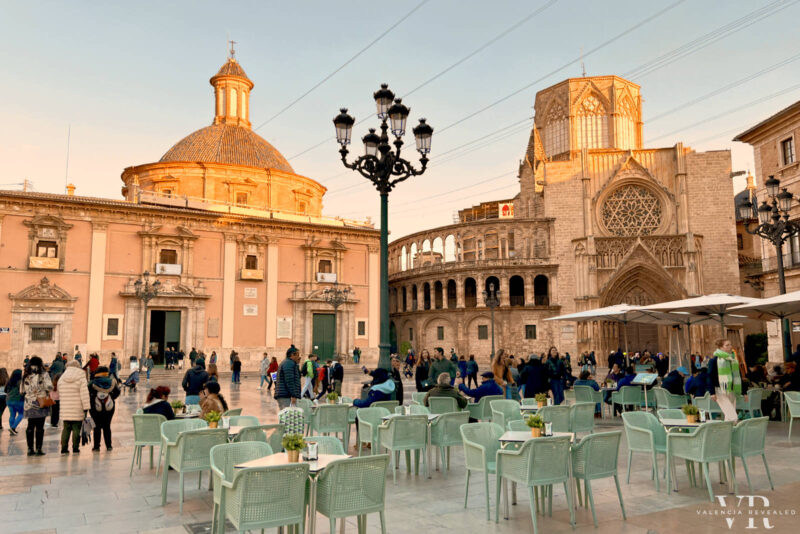
The Old Town is the beating heart of Valencia. It was built one civilisation on top of the other, since the Romans founded Valentia over two millennia ago.
So as you can imagine, this part of Valencia hides many secrets that are not obvious at a first glance.
If you want to hear the stories behind the buildings and discover hidden corners you wouldn’t otherwise find on your own.
Pamper yourself with a spa treatment
Valencia doesn’t have a big spa culture, but if you know where to look, you can surely find some pretty amazing spas circuits to help you wash away the stress.
Most spa facilities are nestled within hotels, but you don’t always have to splurge on accommodation to have access to them.
A prime example is the exquisite Spa Cobre 29 at Hotel Meliá, where you can book a rejuvenating 75-minute spa circuit, even if you’re not a guest.
Take a dip in a hot spring
If you’d rather enjoy the benefits of thermal waters in a natural settings, Valencia has some absolutely stunning hot springs nearby.
Most of them are suitable for taking a dip until late November, but the Montanejos hot springs have a steady temperature of 25ºC (77ºC) year round.
These natural pools have therapeutic benefits and some people like to go for a swim here in winter in spite of the relatively chilly outdoor temperatures. The easiest way to get there is by joining an organized tour.
Watch a flamenco show
During the winter in Valencia, there are few indoor activities as entertaining as attending a traditional flamenco show.
These performances take place in the evening when the temperatures have dropped. So, instead of retreating to your hotel room, you can immerse yourself in the local culture.
The shows are typically held in cozy tablaos such Palosanto and you can enjoy a couple of drinks while watching the performance. Some places also serve dinner. Check out the best flamenco venues in Valencia.
Pedal your way around Valencia
Cycling in the Northern hemisphere during the cold winter months can be quite unpleasant and challenging.
But in Valencia you can have a nice biking experience throughout winter without having to worry about freezing hands or wearing warm gloves.
Bikes are a great transportation method for exploring the city, traveling between attractions, and along the Turia Park.
You can either rent a bike from one of the many bike rental shops in Valencia or join a bike tour.
Marvel at the frescoes inside the San Nicolás Church
Valencia has many beautiful churches but Iglesia de San Nicolás holds a special place in my heart.
It’s often referred to as the Valencian Sixtine Chapel because of its intricate frescoes that cover every inch of its interior. While smaller in size compared to the cathedral, it has a warm and intimate atmosphere and its name, “San Nicolás”, makes it particularly fitting to visit during the Christmas season.
In December all the way through January 6th, they have a vertical nativity scene on display, which is quite unusual (most Spanish nativity scenes are build in a horizontal layout).
Take a paella cooking class
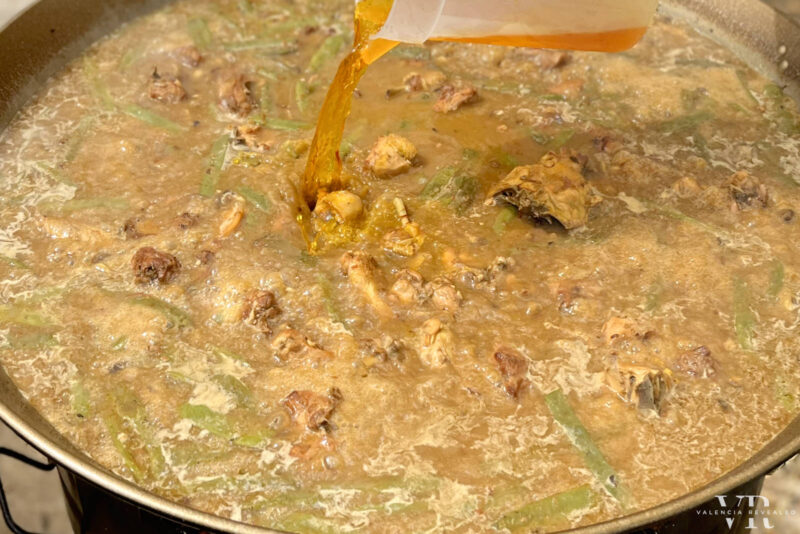
Another indoor activity that’s ideal on a particularly cold winter day or on a rainy one at that, is joining a paella cooking class.
Paella was born in a village located just south of Valencia, so it’s not just a super popular Spanish dish, it’s actually a pillar of Valencian cuisine.
I highly encourage you to try it in one of these paella restaurants, but if you want to return home with a new skill, a paella cooking class is the way to go.
If you want to take your paella experience to the next level, you can also buy a paella pan as a Valencia souvenir.
Also read:
- What Is Paella? All You Need to Know About the World’s Most Popular Rice Dish
- Fun Facts About Paella That Will Make Your Mouth Water
Explore the San José Caves
Located to the north of Valencia, in Vall d’Uixó, the San José caves host the longest navigable underground river in Europe and UNESCO listed rock paintings.
The cave is beautiful lit to highlight all the interesting rock formations and the temperatures inside are a constant 20ºC (68ºF) all year round.
The San José caves can be visited on a half-day trip. But if you don’t have a car or don’t want to drive, the only other way of getting there is by joining a guided tour.
Experience the beauty of Albufera
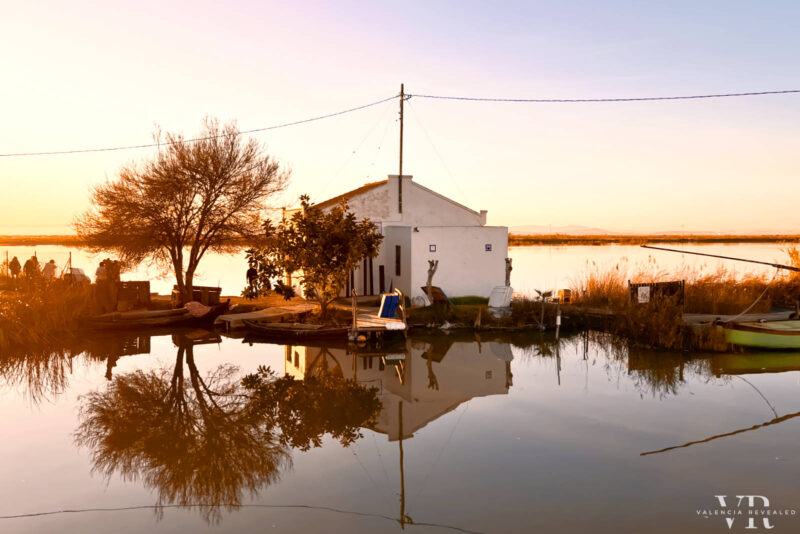
Albufera Nature Reserve is one of the most important wetlands in Spain. It is situated just south of Valencia and it features a large lake surrounded by rice fields.
My favourite seasons for visiting Albufera are summer, when the fields are lush and green, and winter, when the flooded rice fields create a perfect water mirror effect.
The most popular activities include boat rides and bird watching – black or white egrets are abundant and if you’re lucky, you might even spot pink flamingos.
This picturesque scenery is even more enchanting at sunset.
Explore the Fine Arts Museum of Valencia
Museo de Bellas Artes de Valencia is one of the most important museums in Spain.
In fact, as far as fine arts museums go, its importance is only surpassed by El Prado. But unlike El Prado, this museum is free to visit.
If you want to be thorough, you’ll need a whole morning of afternoon to see it all. The museum hosts artworks by many Spanish and Valencian painters as well as an extensive collection of religious paintings.
See a concert at Palau de la Música
Music is the language that needs no words or translation. So if you like classical music, Palau de la Música is a great place to spend a couple of hours while visiting Valencia in winter.
Located inside a modern building in the Turia Park, Valencia’s concert hall has great acoustics and holds weekly concerts.
Many of them feature the local orchestra but they have plenty of international guests as well.
What to eat in Valencia in winter
Valencia has many hearty and comforting dishes perfect for enjoying on a winter day. But maybe what stands out even more are the unique winter sweets and desserts made with warming spices. Here are some foods you should try when in Valencia in winter.
Roasted chestnuts and corn on the cob
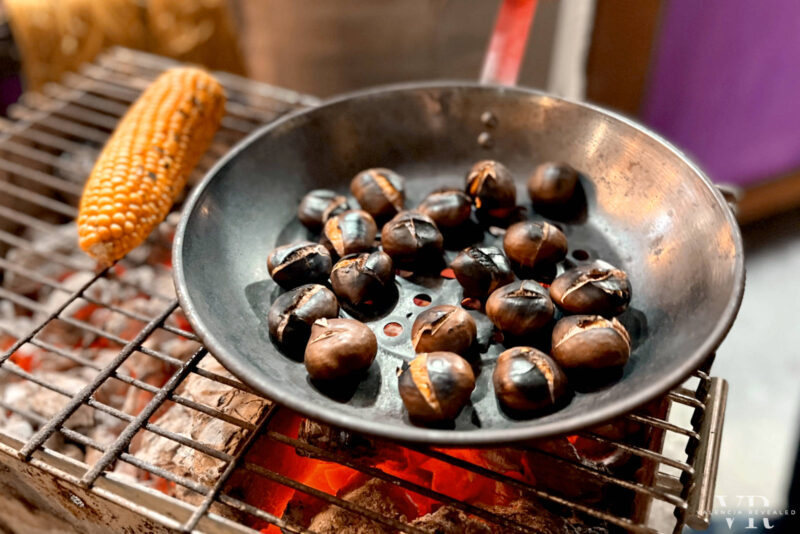
Come winter, street vendors start selling roasted chestnuts and grilled corn on the cob. You can find them all around the city center and close to major attractions such as the City of Arts and Sciences.
Chocolate and churros
Decadent churros and thick hot chocolate are what winter afternoons in Valencia are made of. But when it comes to enjoying this delicious snack there’s truly no wrong time of the day.
Local wines
Winter is a wonderful time to go wine tasting in Valencia and even visit some of the nearby wineries. Valencia has its own appellation. Plus the nearby Utiel-Requena wine region is the oldest in Spain.
Turrónes, mantecados, and marzipans
Some of the most anticipated Christmas sweets in Valencia, turrónes, mantecados, and marzipans start appearing on supermarkets’ shelves and in specialist shops as early as October.
Candied almonds and nuts
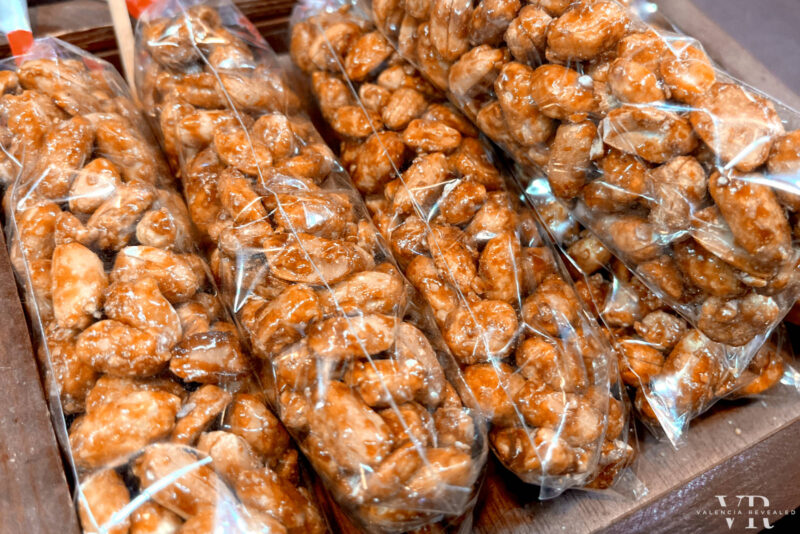
Nothing beats the delightful aroma of candied almonds, right? Even more so if infused with spices, such as vanilla and cinnamon. As soon as the temperatures begin to drop, you’ll come across all kinds of candied nuts and seeds being sold by street vendors, specialty shops, and at Christmas markets throughout Valencia.
Oranges and orange juice
The sweet and juicy oranges cultivated in the region are among the things Valencia is most famous for. Luckily, if you’re visiting Valencia during the winter months, you’ll land right in the middle of the orange harvest season.
Arroz al horno
This baked rice dish made with pork ribs, bacon, and blood sausage is as heartwarming as it is delicious. It’s a typical winter dish from the Valencia region, and during the colder months, you’ll find it on restaurant menus all around the city.
What to pack when visiting Valencia in winter

When preparing for a winter trip to Valencia, you should pack both light and warm clothes. Warm clothes are easily overlooked as many people assume that just because temperatures during the day can reach 20ºC, it’s warm. That’s not always the case.
The highest temperatures are reached in the early afternoon, between 1 pm and 3 pm. But mornings can be chilly – the lowest temperatures are reached around 6 am.
Evenings can also be cold, so it’s good to take this into account if you plan to stay up late. This means packing a jacket and a warm scarf.
Locals wear light puffer and biker jackets on warmer days and switch to parkas and coats at night. Ankle boots are also quite common, even if they are more a fashion statement than a necessity.
If you plan to spend the whole winter in Valencia or if the weather forecast predicts rainy conditions for your visit, consider packing a jacket that is both windproof and waterproof.
Staying in an apartment rental? Look for one with central heating. Central heating is fairly uncommon in Valencia. Combined with poor insulation, this means temperatures indoors can match the ones outdoors.
But central heating or not, it’s best to pack some warm PJs and loungewear to wear indoors, just in case. Many apartments in Valencia have tile flooring and no carpets, so packing warm slippers can come in handy as well.
Apart from this, you should also pack an umbrella, sunglasses, and a reusable water bottle with a filter.
Tap water in Valencia is safe to drink, but it doesn’t have a pleasant taste. If you like to have a reusable water bottle with you at all times, make sure it has a filter so you don’t end up buying bottled water sold in plastic from the supermarket.
Last but not least, if you’re traveling from a country outside of the EU, check if you need to pack a converter and/or adapter for all your electronics.
Where to stay in Valencia in winter
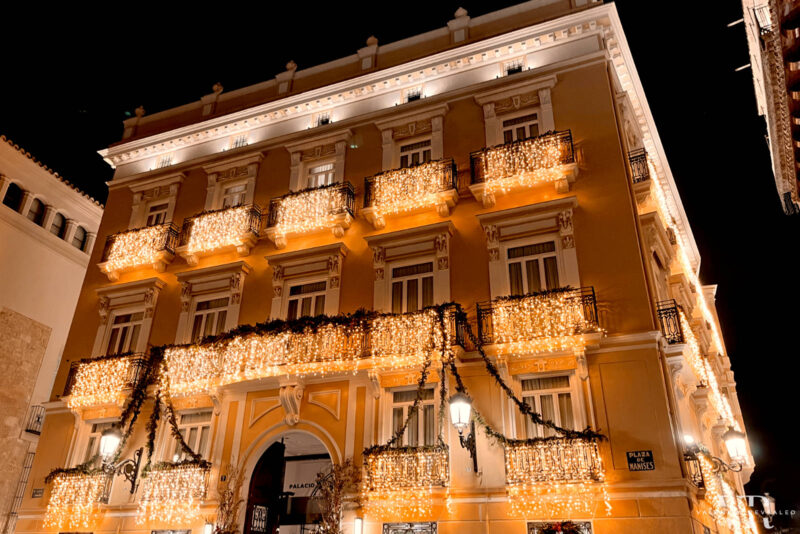
To enjoy the charms of Valencia in winter, I recommend staying in the Old Town or Ruzafa. This way you’ll be right in the middle of the action and avoid any unnecessary commuting.
What I don’t recommend is staying near the beach. Valencia’s seaside is less lively this time of the year and it can be quite windy. When it rains a lot, it can even get flooded.
For hotel suggestions, make sure you check out my Valencia accommodation resources:
- Most Elegant Boutique Hotels in Valencia
- Best Luxury Hotels in Valencia For a Pampered Stay
- Where to Stay in Valencia: An Insider’s Guide to the Best Areas
Frequently asked questions about winter in Valencia
Here are a few common question I get asked about visiting Valencia in winter.
Is Valencia worth visiting in winter?
Yes, Valencia is definitely worth visiting in winter if you want to escape the cold and enjoy some winter sun.
While restaurants, tapas bars, and cafés remain busy during this time, most tourist attractions are considerably less crowded.
On top of that, the generally sunny and pleasant weather makes it possible to enjoy leisurely strolls along Valencia’s beautiful beaches and parks all winter long.
What is Valencia like at Christmas?
In the weeks before Christmas, many streets and buildings throughout Valencia are adorned with twinkling Christmas lights.
Wonderful displays of nativity scenes pop up around the city and there are many irresistible Christmas treats you can enjoy.
While Valencia is not big on Christmas markets, it does have several small ones where you can buy all kinds of locally produced, handmade goods. To learn more, make sure you also read my guide to Christmas in Valencia.
Does it snow in Valencia in winter?
No! Since temperatures don’t get below freezing, it almost never snows in Valencia.
In fact, snow has settled in Valencia on just three occasions since 1856, the year when meteorological data started being officially recorded.
The last time the streets of Valencia were covered in a snow blanket was on January 11th, 1960. At the beginning of February 2015, a few snowflakes fell, most of them melting before reaching the ground.
How cold does it get in Valencia in winter?
Winter temperatures in Valencia can approach freezing levels, but they rarely reach 0ºC (32ºF).
But beware that the perceived temperature can be several degrees lower than the thermometers indicate. This is particularly noticeable on windy days when cold winds from the east or north can create a chillier sensation.
Is Valencia nice in December?
Valencia is a nice December destination, thanks to all the festive decorations and activities organized throughout the city.
Welcoming the New Year in Valencia can feel particularly special as the city celebrates with a big street party in the City Hall Square.
December also tends to be dryer and sunnier than the other winter months. Read more about visiting Valencia in December.
Is Valencia nice in January?
January can also be a nice time to visit Valencia. Winter holidays last until January 6th culminating with a dazzling parade on January 5th – the Cavalcade of the Magi, which is one of the most popular celebrations in Valencia.
After that, things slow down, but January sees plenty of sun. This means that on most days, you can enjoy a nice cup of coffee on a terrace around noon. Read more about visiting Valencia in January.
Is Valencia warm in February?
The first half of February tends to be colder than the second half. So as we progress into the second half of February, temperatures gradually begin to rise.
A light jacket is usually all you need on the last days of February. March is already considered spring in Valencia, and there are days when you can easily wear a T-shirt for several hours around noon. Read more about visiting Valencia in February.


